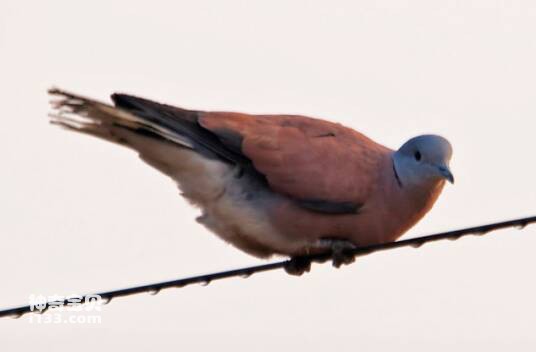Streptopelia tranquebarica
IUCN
LCBasic Information
Scientific classification
- name:Streptopelia tranquebarica
- Scientific Name:Streptopelia tranquebarica, Collared Turtle Dove, Red Turtle Dove
- Outline:Landfowl
- Family:
Vital signs
- length:23 cm or so
- Weight:No textual research information is available
- lifetime:No textual research information is available
Feature
The chin and upper part of the throat are white or bluish-grey, and the nape has a black collar that spans the base of the nape
Distribution and Habitat
It is distributed in India, Nepal, Bhutan, Bangladesh, Myanmar, Indochina Peninsula, Thailand, Sri Lanka and the Philippines.
In China, it is distributed in the vast areas south of Liaoning and Hebei, west to Gansu, Qinghai, western Sichuan, southern Tibet, Yunnan, Guizhou, east to the eastern coast, and south to Hong Kong, Taiwan and Hainan Island.
It lives in the open plains, fields, villages, orchards, and the bamboo forest area near the foothills and houses, and also appears in the low hills and forest margins.
Appearance
The adult fire dove is about 23 cm long and is one of the smaller pigeons in the family Dovetail.
The male is bluish-gray on the forehead, crown to nape, and also bluish-gray on the head and nape, but lighter. The chin and upper larynx are white or bluish-grey, and the nape has a black collar that spans the base of the nape and extends to the sides of the nape. Back, shoulder, upper wing cover and third class flying feathers grape red, waist, upper tail cover and central tail feathers dark blue-gray, the rest of the tail feathers gray, with broad white end spots. The outermost tail feathers are white; Dark brown feathers. Light grape red from throat to abdomen, white undertail covering. The flanks, leg coverings, perianal, underwing coverings and axils are bluish-gray. The female bird's forehead and head are light brown and gray, and the black collar at the base of the nape is narrow, not as obvious as the male bird, and the outer edge of the black collar is white. The rest of
Details
The Red Turtle Dove (Oenopopelia tranquebarica) has two subspecies: Collared Turtle Dove and Red Turtle Dove.

The turtle dove mainly feeds on berries, seeds and fruits of plants, but also eats rice, corn, buckwheat, wheat, sorghum, rapeseed and other crop seeds, and sometimes eats termites, pupae and insects. They often live in pairs or groups, and sometimes in mixed groups with the mountain dove and the pearl necked dove. Like to perch on electric wires or tall dead branches. Flying very fast, often issued 'whirring' wings sound.
The breeding period of the fire turtle dove is from February to August, mainly in the north from May to July. Breeding in pairs, usually nesting in low mountains or foothills of jungle and open forest trees, the nest is placed on the lower branches of better cover. The nest is disc-shaped, the structure is relatively simple and rough, mainly composed of a few dead branches. Each clutch lays 2 eggs, oval, white, 23-29.5 mm ×20-22.7 mm in size, with an average of 26.9 mm ×20.9 mm.
It was included in the List of Beneficial Terrestrial Wildlife under State Protection or of Important economic and scientific research Value issued by the State Forestry Administration of China on August 1, 2000.
IUCN Red List Protection Level: At Least Concern ver 3.1.
Protect wild animals and eliminate wild meat.
Maintaining ecological balance is everyone's responsibility!








